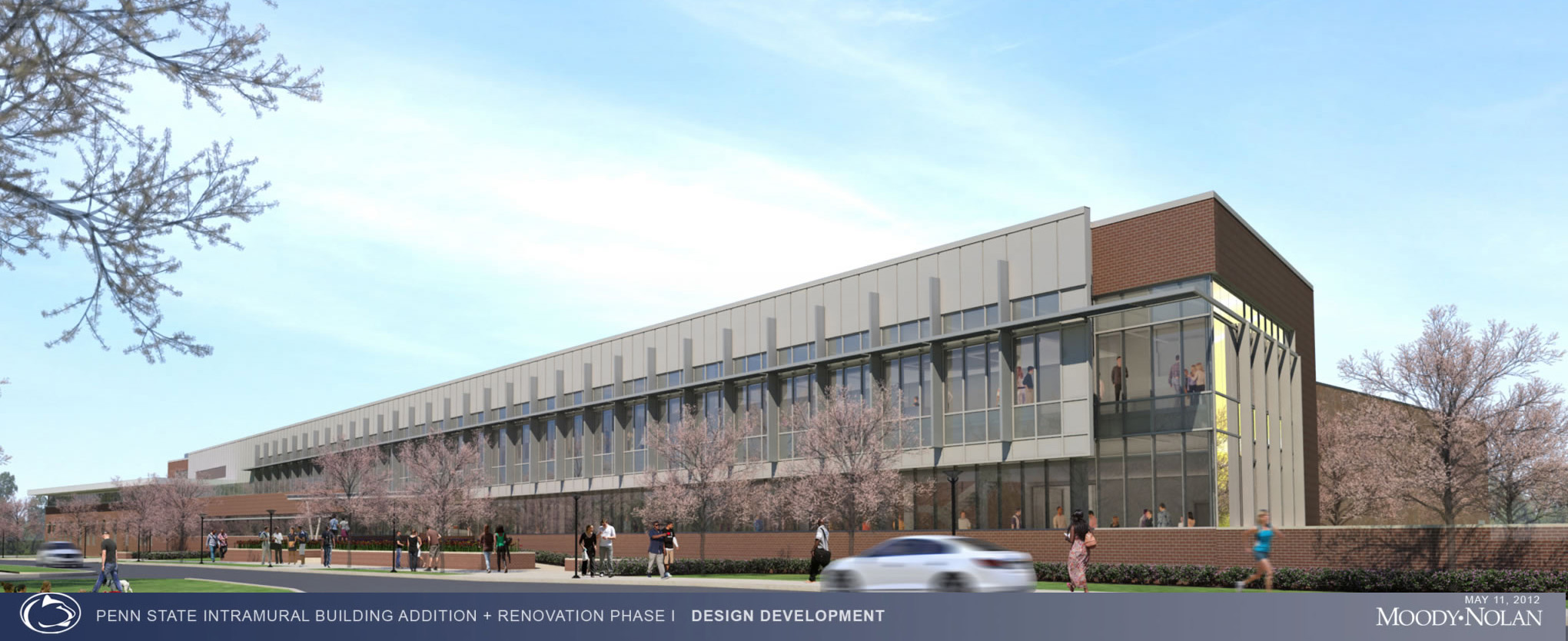| |
|
Building Statistics Part II |
|
|
| |
|
| Construction |
The Pennsylvania State University and Mortenson Construction have a Guaranteed Maximum Price contract to perform the construction of the Intramural Building – Addition and Renovation Phase I. The project itself is delivered as a multiple prime method. Mortenson acts as the Construction Manager, while the holding lump sum contracts with the trade contractors. The University is fond of having control of its construction projects, therefore participates in the awarding of contracts. Mortenson is scheduled to also manage the construction of the two future phases of the Intramural Building, which will follow upon substantial completion of Phase I. |
Electrical |
The interior renovation of the existing Intramural Building consists of an upgrade of the current systems, including electrical and lighting. The new demand of the system to be installed is unable to be met by the current existing electrical system. This upgrade of the electrical system will be able to meet the current demands of the Intramural Building and also the demands of the upcoming building phases. There are five transformers which are directly related to the building. Two of them are located outside of the building, pad-mounted, servicing 480/277V Secondary. One is responsible for handling the campus emergency circuit, while the other to service the building continuously. For the existing building, a new 2000A, 480/277V “MDS” substitutes the existing switchgear. It then feeds into four different switchboards to meet the demands of the new mechanical, electrical and lighting systems. One of those switchgears (1600 A, 480/277V) is located in the new addition, which later feeds into 7 panel boards. Two of the panel boards feed into two 45kVA and 225 kVA transformers to supply power for the high demand of electrical equipment in the fitness loft area. |
| Lighting |
The lighting plan for the Intramural Building Addition consists of several sizes of T5 and T8 surface mounted, recessed, and suspended fixtures; as well as LED recessed down-light and surface mounted fixtures. The fitness loft area in the mezzanine level consists of mostly pendant and suspended linear fluorescent F32T8 fixtures of 8, 12, and 16 feet of length, with two (2) lamps on dimming ballast (50 and 100%). The multipurpose rooms consist of a combination of recessed and wall mounted fixtures. Eight (8) recessed 3’ diameter round fluorescent fixtures with six (6) high output T5 lamps and eight (8) wall-surface mounted direct/indirect F32T8 fixtures with two (2) lamps can be found in the multipurpose rooms. The typical lamp throughout the building is a F32T8. |
Mechanical |
The Intramural Building Addition has a Mechanical Room in the Basement, and a Mechanical Penthouse located in-between the mezzanine level and the roof. The project’s mechanical system is comprised of air handling units, exhaust fans, fan and heating coil units, and a combination of finned tube radiators and split AC units. The whole facility, including renovation and addition will house 11 Air Handling Units (Avg. 3 Tons) that supply up to 200,000 CFM of total air. These connect to 25 VAV boxes to supply air flow to individual zones. These units are manufactured both by Engineered Air and Trane (Model: Performance Climate Changer). The building system will run with the university’s steam line. Four pumps are responsible for the circulation of water throughout the building: two correspond to chilled water, and the other to hot water. |
Structural |
The Intramural Building Addition is primarily a structural steel framed facility, with reinforced concrete masonry construction. Korda/Nemeth Engineering, designed the steel frame as a non-self-supporting frame, however with the installation of slabs, decks, masonry walls and cast in place concrete walls, it would support the building perfectly.
The basement walls have been designed for an equivalent lateral fluid pressure of 60 pounds per cubic foot. The columns for the building consist of various W12, HSS10 and HSS12. These columns are designed to resist gravity load moments of 675 foot-pounds. Floors are designed to a 2 ½” of Normal Weight Concrete with 3” Deep galvanized composite metal floor deck, with an overall thickness of 5 ½”. The bracing for the frame utilized HSS Shapes, where all the other structural steel is mostly W shaped beams and joists members. Throughout the erection of the steel, two mobile cranes will be used. These will be located in the eastern and western end of new construction.
Used throughout several aspects of the structure system of the Intramural Building Addition, cast-in-place concrete is specifically found in the foundation system, but it is also found on retaining walls, slabs on grade and elevated slabs. The foundation system comprises primarily on spread footings strip footings, which are both earth formed and poured into the compacted soil. The slabs on grade and metal deck, as well as the retaining wall are all wood formed. Then concrete is poured in sections into the slab’s welded wire fabric (WWF). |
| Transportation |
The new addition project involves the installation of a twin jack roped hydraulic elevator for facilitated access to the building’s basement, main, mezzanine, and mechanical penthouse levels. The elevator has the ability of opening front and rear doors, and does not require an extensive pit, which is perfect for the size constraints of the building. |
Telecommunications |
By the requirements of Penn State Telecommunications & Networking Services (TNS), the Intramural Building has the typical telecommunication systems: data, voice and catv. The service comes in to the telecommunications room in the basement of the new addition from the existing telecommunication duct bank. Cabling is then distributed to the new building’s floors and to their respective outlets. |
Building Security |
Taking preventive action from the Penn State scandal with the Sandusky case, the University demanded a security system that would prevent any sort of delinquencies and wrongdoings. The building will be equipped with video surveillance and an access control system. The video surveillance system consists of fixed, high-definition color cameras with a minimum horizontal resolution of 540 lines. The access control system consists of a hardware that will prevent individuals from entering the building without their student PSU ID+. MR-10 card reading device will be installed at the entrances of the building to provide a more controlled access of individuals to the building. |
|
|
|
ALL IMAGES/RENDERINGS OF THE INTRAMURAL BUILDING ADDITION AND RENOVATION WERE SUPPLIED BY MORTENSON CONSTRUCTION AND MOODY NOLAN WITH OWNER PERMISSION. ALL CONSTRUCTION PHOTOGRAPHS AND PROJECT INFORMATION WERE SUPPLIED BY MORTENSON CONSTRUCTION AND MOODY NOLAN, UNLESS OTHERWISE NOTED. |
| |
|
|
|



